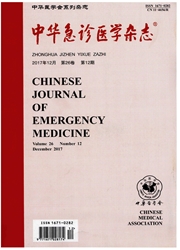

 中文摘要:
中文摘要:
目的汇集有关ST段抬高型心肌梗死(ST—elevation myocardial infarction,STEMI)所致院外心脏骤停(out—of-hospital cardiac arrest,OHCA)的文献,分别对冠脉介入(percutaneous coronary intervention,PCI)与静脉溶栓在自主循环恢复(return of spontaneous circulation,ROSC)后患者中的疗效进行比较;通过揭示两种疗法对此阶段患者存活出院及神经功能恢复方面的作用,明确ROSC阶段治疗的重要性,以期指导对由STEMI所致OHCA患者的救治。方法本研究通过查询PUBMED和MEDLINE数据库,对1995年1月至2011年10月间的有关STEMI所致OHCA的研究文献进行了回顾性分析,以获得ROSC的OHCA患者为研究对象,相关患者的存活出院率和神经功能良好率作为此项研究的评判标准。共有18篇文献纳入此项研究,由于Meta分析必须是同期对照性研究,笔者将同一队列研究中获得ROSC后接受PCI的患者作为治疗组、拒绝PCI的患者作为对照组;与之相应,接受静脉溶栓的患者作为治疗组、拒绝静脉溶栓的患者作为对照组;然后,利用Review Manager5.1软件对各自相应的治疗组与对照组间进行Meta分析。此外,也对PCI与静脉溶栓两种疗法对此类患者的出院率及神经功能良好率问的差异,采用Pearson χ^2进行比较。结果在由STEMI所致OHCA的患者中,Meta分析显示了对ROSC后患者的存活出院率方面PCI[OR(odds ratio,优势比),1.65;95%CI(confidence interval,可信区间),1.05—2.59,P〈0.01]与静脉溶栓(OR,2.03;95%CI,1.24~3.34,P〈0.01)明显优于各自的对照组;总体比较中,静脉溶栓与PCI在此类患者的存活出院率(63.00%VS.65.19%,P=0.548)及神经功能恢复率(88.62%VS.91.25%,P=0.351)方面具有相似的结果。结论对STEMI所致的OHCA患者,在ROSC后进行PCI或静脉溶栓能够提高存活出院率;静脉溶栓在救治此类
 英文摘要:
英文摘要:
Objective To evaluate the effect of percutaneous coronary intervention (PCI) or thrombolysis, in patients with return of spontaneous circulation ( ROSC ) after out-of-hospital cardiac arrest (OHCA) , in the presence of ST-elevation myocardial infarction (STEMI). We demonstrated the benefits of the two therapies on ROSC patients in hospital discharge and neurological recovery, and clarified the importance of ROSC, so as to guide the treatments for OHCA in the presence of STEMI. Methods It was performed a meta-analysis of clinical studies located in PUBMED and MEDLINE databases from January 1995 to October 2011. OHCA patients with ROSC were as our study objects, the hospital discharge and neurological recovery rates, of patients with and without PCI or thrombolysis, were assessed in patients with ROSC after OHCA in the presence of STEMI. In the same Cohort Study, between received and rejected PCI, or between received and rejected thrombolysis in OHCA patients with ROSC as treated group and control group, using Review Manager 5. 1 software to analyze, respectively. Furthermore, we also compared the differences in hospital discharge and neurological recovery rates between patient groups who received PCI or thrombolysis by Pearson χ^2 analysis. Results The meta-analysis showed that the rate of hospital discharge improved with both PCI (odds ratio [ OR], 1.65 ; 95% confidence interval [ CI], 1.05-2. 59, P 〈 0. 01 )and thrombolysis ( OR, 2. 03 ; 95% CI, 1.24-3.34, P 〈 0. 01 ) in patients with ROSC after OHCA, in the presence of STEMI. We also found that there were not significant differences between with PCI and with thrombolysis in the rate of hospital discharge (63.00% vs. 65. 19% , P = 0. 548) and neurological recovery (88.62% vs. 91.25%, P =0. 351) for the patients with ROSC after OHCA (P 〉0. 05). Conclusions In patients with ROSC after OHCA in the presence of STEMI, both PCI and thrombolysis improved hospital discharge rates. Furthermore, there were similar efficacy in hos
 同期刊论文项目
同期刊论文项目
 同项目期刊论文
同项目期刊论文
 The changes of brain water diffusion and blood ?ow on diffusion-weighted and perfusion-weighted imag
The changes of brain water diffusion and blood ?ow on diffusion-weighted and perfusion-weighted imag Comparing percutaneous coronary intervention and thrombolysis in patients with return of spontaneous
Comparing percutaneous coronary intervention and thrombolysis in patients with return of spontaneous Comparing the diagnostic values of circulating microRNAs and cardiac troponin T in patients with acu
Comparing the diagnostic values of circulating microRNAs and cardiac troponin T in patients with acu Changes in expression of Nogo receptor 1 in hippocampus and cortex after cardiopulmonary resuscitati
Changes in expression of Nogo receptor 1 in hippocampus and cortex after cardiopulmonary resuscitati Soluble NgR fusion protein modulates the proliferation of neural progenitor cells via the Notch path
Soluble NgR fusion protein modulates the proliferation of neural progenitor cells via the Notch path Enhanced external counterpulsation improves cerebral blood flow following cardiopulmonary resuscitat
Enhanced external counterpulsation improves cerebral blood flow following cardiopulmonary resuscitat Early Enhanced External Counter Pulsation Improves Neurological Recovery After the Return of Spontan
Early Enhanced External Counter Pulsation Improves Neurological Recovery After the Return of Spontan 期刊信息
期刊信息
